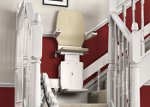Exploring Your Options and Choosing the Right Type of Stair Lift
Published by Stephen on February 20, 2010 Under stair lifts For most individuals, the stairs present enough of a risk that it is important to use the banister for support when walking down the stairs, as well as avoiding playing around them. However, for seniors and those with diseases like arthritis that affect their mobility, the stairs are much more dangerous. This is not just because of the increased risk of a fall, which is much higher among the elderly, but also because a serious injury is also much more likely to occur. To help make the stairs not just safer, but also considerably easier to use, many seniors rely on stair lifts.
For most individuals, the stairs present enough of a risk that it is important to use the banister for support when walking down the stairs, as well as avoiding playing around them. However, for seniors and those with diseases like arthritis that affect their mobility, the stairs are much more dangerous. This is not just because of the increased risk of a fall, which is much higher among the elderly, but also because a serious injury is also much more likely to occur. To help make the stairs not just safer, but also considerably easier to use, many seniors rely on stair lifts.
What Are Stair Lifts and How Do They Work?
Stair lifts are a low cost alternative to a residential elevator. Unlike personal elevators that require the entire home to be modified and a shaft built specifically for the elevator, most stair lifts can be installed onto a stairway with little actual modification to the homes structure. Instead, the stairway lift can be installed onto the steps and set up in a few hours, often by the homeowner themselves, which further saves money.
The basic design of the stair lift is similar across the different models. Most provide a chair for the user to sit in that is attached to a metal track running the distance of the staircase. As the chair moves along the metal track, it carries the occupant safely up and down the stairs. This is why stair lifts are often called stair chairs, but standing stair lifts are also available. However standing stair lifts, or perch lifts, are not as safe to use as a stair chair, because the person must remain standing as the lift is in motion.
The chair or perch is moved along the track using an electric motor, which is either directly powered or run off of rechargeable batteries. In the case of the latter, the battery powered stair lift, the upfront cost is higher, but it can still be used if the home looses power.
What Are the Different Types of Stair Lifts?
There are a few different types of stair lifts and when selecting the right stair lift, a large part of the choice is determined by what type of staircase is present. For example, those with a staircase with a curve will need a curved stair lift, which is very expensive and usually requires a professional installation.
Those with a staircase that has a landing or a landing with a square bend, will also need a special type of stair lift, but there are many less expensive options for 90 degree “L” Shaped stair cases. In fact, there are even several stair lift kits that can be installed by the homeowner and are designed to work with these types of staircases, including ones with 180 degree bends.
The least expensive option is the straight stair lift, which is designed to work with staircases that are completely straight and do not have a landing or other break in between the top landing and the bottom landing. The reason straight stair lifts are so inexpensive is because the stair lift is because the stair lift manufacturer can simply cut the track to length and ship it out, with out having to custom bend or shape the track. Not only does this make the shipping time much quicker than other stair lifts, often within a day or two of order, but it also makes them much easier to install. There are a number of popular do-it-yourself stair lift kits available, which are intended to be quickly and easily installed. As a result, straight stair lifts are one of the least expensive options.
Stair lifts provide a safe and inexpensive way to make the stairs safer and easier to use for seniors, then elderly, and others with conditions that make bending the knee or walking more difficult. Where installing an elevator can take weeks, requires a great deal of construction, and can easily cost over $30,000, you can usually install a stair lift in an afternoon, often for around $1500.
No Comments |
Add a Comment